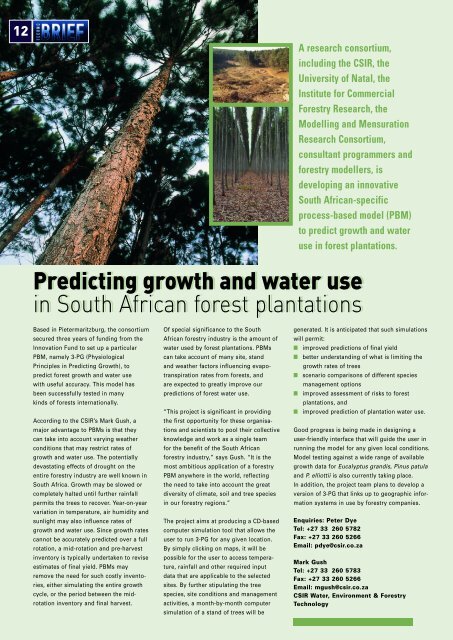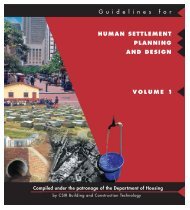11The largest environmental programme inAfrica continues to tackle alien invasivesLeft: Invasive Australian wattles have beenbrought under control through the introduction ofgall-forming wasps which prevent the productionof seedsWith an annual budget of R400 million, theWorking for Water programme is arguablythe largest single environmental programmeon the African continent. By theend of the 2001/2 financial year, the programmehad invested R1,59 billion in clearingprogrammes during its first seven yearsof existence. It has received widespreadinternational acclaim and many awards.Launched in 1995 in an effort to tackle theproblem of invading alien plants and unemployment,the Working for Water programmeis a multi-departmental initiativeled by the Departments of Water Affairsand Forestry (DWAF), Environmental Affairsand Tourism and Agriculture. The programmeaims to enhance water security,improve ecological integrity, restore theproductive potential of land, promote sustainableuse of natural resources and investin the most marginalised sectors of SouthAfrican society.“The <strong>CSIR</strong>’s role was initially to provide thelogistical support and capacity to start theprogramme and manage it through its firstyear of existence,” says Dr Brian vanWilgen of <strong>CSIR</strong> Water, Environment andForestry Technology. “Subsequently, theorganisation provided support in transferringthe management of the programme toDWAF, and assisting in transformation. Italso set up and ran a research programmeto support Working for Water, conductingfocused research into mainly hydrologyand resource economics.”The name of the programme captures itsfocus on job creation in support of animportant ecosystem service (the protectionof water supplies threatened by invasivealien plants). The invasion of ecosystemsby alien species that are knowinglyor accidentally introduced to new areas isa problem of global significance. Theseinvasions can alter the composition, structureand functioning of ecosystems andaffect their capacity to deliver a range ofbenefits to humankind.The prime argument for the establishmentof the Working for Water programme wasthe prediction that these invasions wouldhave severe impacts on surface waterresources. Initial funding from DWAF,aimed at the prevention of these putativeconsequences, has been combined withfurther generous funding from thegovernment’s allocation to poverty relief.This intervention has created thousandsof employment opportunities, andenhanced the lives of poor people inimpoverished rural areas.There has been a strong focus on gettingmost of the funds to poor people; however,the programme has more recentlyinvested funds (amounting to R42 millionover the past three years, or roughly 2,5%of the current annual programme budget)into much-needed research aimed at supportingdevelopment and implementation.There is no doubt that the Working forWater programme has, through itsfunding of relevant research, createdstimulus for continued achievements inthis field by South African scientists.Middle: Working for Water employee clearinginvasive rooikrans (Acacia cyclops) in the WestCoast National ParkRight: Specially-trained Working for Water teamsclearing invasive pines from the steep slopes of amountain catchment areaSays van Wilgen, “The programme’sactivities provide extraordinary opportunitiesfor innovative experimentation andresearch. The range of ecosystems inwhich clearing operations are located andthe scale of operations, combine to offeropportunities that are rarely foundanywhere else. We have not yet fullycapitalised on these prospects, and thisremains largely unexploited opportunitiesfor scientists.”In a recent special issue of the SA Journalof Science (March <strong>2004</strong>), edited by vanWilgen, 17 <strong>CSIR</strong> researchers contributedas authors or co-authors of 11 of the 19papers in the issue. “This is indicative ofthe level of support the <strong>CSIR</strong> has providedthe programme,” comments van Wilgen.”Enquiries: Dr Brian W van Wilgen<strong>CSIR</strong> Water, Environmentand Forestry TechnologyTel: +27 21 888 2479Fax: +27 21 888 2693Email: bvwilgen@csir.co.za
12A research consortium,including the <strong>CSIR</strong>, theUniversity of Natal, theInstitute for CommercialForestry Research, theModelling and MensurationResearch Consortium,consultant programmers andforestry modellers, isdeveloping an innovativeSouth African-specificprocess-based model (PBM)to predict growth and wateruse in forest plantations.Predicting growth and water usein South African forest plantationsBased in Pietermaritzburg, the consortiumsecured three years of funding from theInnovation Fund to set up a particularPBM, namely 3-PG (PhysiologicalPrinciples in Predicting Growth), topredict forest growth and water usewith useful accuracy. This model hasbeen successfully tested in manykinds of forests internationally.According to the <strong>CSIR</strong>’s Mark Gush, amajor advantage to PBMs is that theycan take into account varying weatherconditions that may restrict rates ofgrowth and water use. The potentiallydevastating effects of drought on theentire forestry industry are well known inSouth Africa. Growth may be slowed orcompletely halted until further rainfallpermits the trees to recover. Year-on-yearvariation in temperature, air humidity andsunlight may also influence rates ofgrowth and water use. Since growth ratescannot be accurately predicted over a fullrotation, a mid-rotation and pre-harvestinventory is typically undertaken to reviseestimates of final yield. PBMs mayremove the need for such costly inventories,either simulating the entire growthcycle, or the period between the midrotationinventory and final harvest.Of special significance to the SouthAfrican forestry industry is the amount ofwater used by forest plantations. PBMscan take account of many site, standand weather factors influencing evapotranspirationrates from forests, andare expected to greatly improve ourpredictions of forest water use.“This project is significant in providingthe first opportunity for these organisationsand scientists to pool their collectiveknowledge and work as a single teamfor the benefit of the South Africanforestry industry,” says Gush. “It is themost ambitious application of a forestryPBM anywhere in the world, reflectingthe need to take into account the greatdiversity of climate, soil and tree speciesin our forestry regions.”The project aims at producing a CD-basedcomputer simulation tool that allows theuser to run 3-PG for any given location.By simply clicking on maps, it will bepossible for the user to access temperature,rainfall and other required inputdata that are applicable to the selectedsites. By further stipulating the treespecies, site conditions and managementactivities, a month-by-month computersimulation of a stand of trees will begenerated. It is anticipated that such simulationswill permit:■ improved predictions of final yield■ better understanding of what is limiting thegrowth rates of trees■ scenario comparisons of different speciesmanagement options■ improved assessment of risks to forestplantations, and■ improved prediction of plantation water use.Good progress is being made in designing auser-friendly interface that will guide the user inrunning the model for any given local conditions.Model testing against a wide range of availablegrowth data for Eucalyptus grandis, Pinus patulaand P. elliottii is also currently taking place.In addition, the project team plans to develop aversion of 3-PG that links up to geographic informationsystems in use by forestry companies.Enquiries: Peter DyeTel: +27 33 260 5782Fax: +27 33 260 5266Email: pdye@csir.co.zaMark GushTel: +27 33 260 5783Fax: +27 33 260 5266Email: mgush@csir.co.za<strong>CSIR</strong> Water, Environment & ForestryTechnology

















